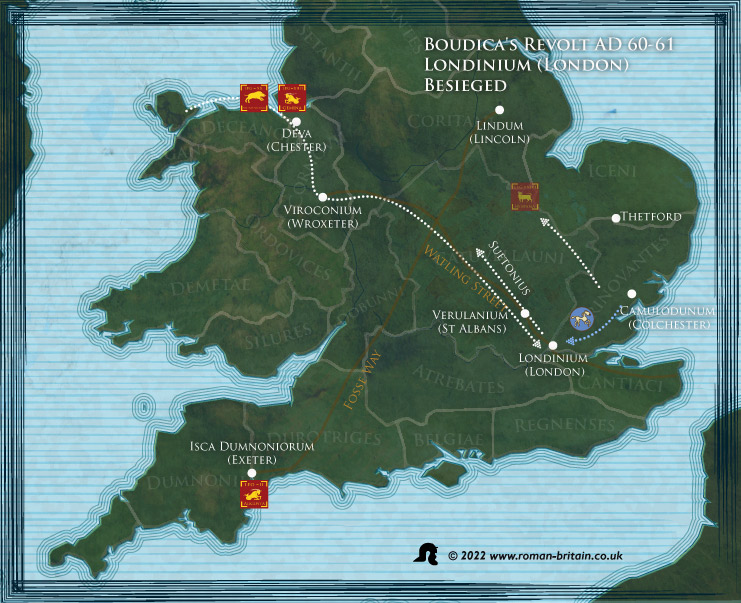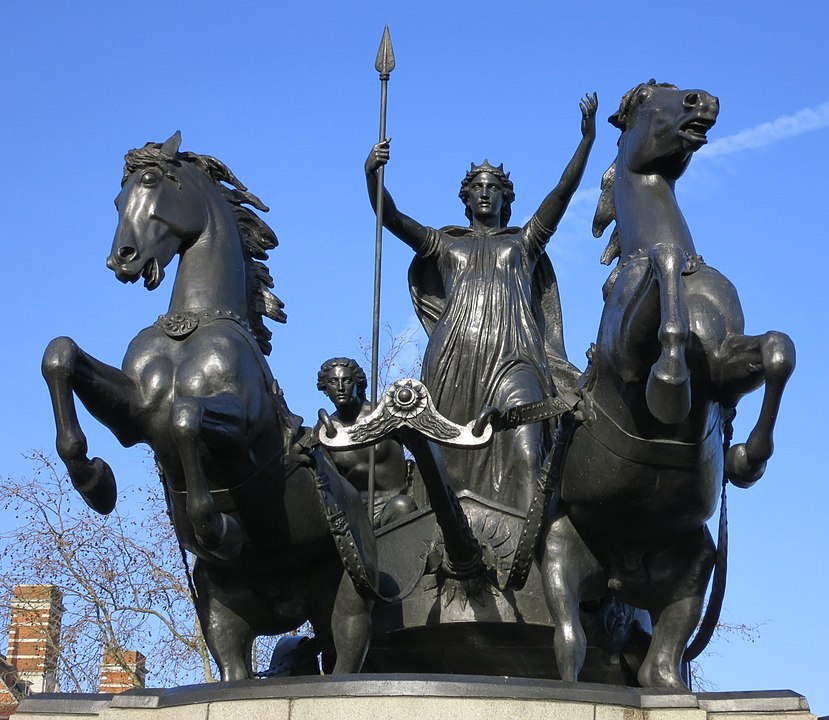When the Iceni and Trinovtmtes attacked Colchester(Camulodunum), the military governor of the province, Gaius Suetonius Paulinus, was on a campaign far away in north Wales. His objective was the capture of Anglesey (Mona), an island whose already significant population had been swollen by refugees; their antagonism to Rome was sustained by the Druid priesthood resident there. The Roman army managed to make the crossing from the mainland and was engaged in extinguishing resistance on the island when news of the destruction of Colchester reached the governor.
Suetonius would have felt then the urgent need to see for himself the extent and state of the Revolt and so broke off the Anglesey campaign at once. Accompanied by a detachment of cavalry, he hastened south through disaffected country to London, the legions and auxiliaries following behind.
The distance from Anglesey to London by road is about 250 miles, but he could have sailed by a fast galley, assisted by the westerly winds, to Chester and reduced his road journey to about 180 miles, which could have taken him three or four days of hard riding with a detachment of cavalry.
Suetonius, however, with wonderful resolution, marched amidst a hostile population to Londinium, which, though undistinguished by the name of a colony, was much frequented by a number of merchants and trading vessels. Uncertain whether he should choose it as a seat of war, as he looked round on his scanty force of soldiers, and remembered with what a serious warning the rashness of Petilius had been punished, he resolved to sacrifice the single city of London to save the province as a whole. Nor did the tears and weeping of the people, as they implored his aid, deter him from giving the signal of departure and receiving into his army all who would go with him. Those who were chained to the spot by the weakness of their sex, or the infirmity of age, or the attractions of the place, were slaughtered by the enemy.
Tacitus: Annals: Book Fourteen: XXXIII Londinium (London) and Verulamium (St Albans) follow
Tacitus tells us that he reached London before the Britons and was able to see the position for himself. He saw for himself that the defence of London was a hopeless one. He then made the hard decision to abandon London to its fate and re-join his army on its long march south-east from north Wales. Despite the entreaties of the population, London was left to its own devices. Those Londoners who were able accompanied Suetonius on the retreat. Women, the elderly, and those who were particularly attached to the place stayed behind.

Roman London (Londinium)
London (Londinium) was a Roman creation: there was no prehistoric settlement on its site. It was built on a key position at the lowest bridging point of the Thames, on the hub of the new Roman trunk road network. Londinium came into being c.AD 50 as a town founded by immigrant craftsmen, financiers and merchants. Its population included a potter from western Switzerland called Caius Albucius, a manufacturer of blown glass and a cutter of intaglio sealstones, all newcomers to Britain bringing new skills. Tacitus describes Londinium:
Londinium, which, though undistinguished by the name of a colony, was much frequented by a number of merchants and trading vessels
Tacitus: Annals: Book Fourteen: XXXIII Londinium (London) and Verulamium (St Albans) follow
Despite its strategic importance, no fort was apparently placed at Londinium for its protection. The nucleus of the first London lay east of the Walbrook stream, on the hillock at Cornhill where the road from the Thames crossing met the east-west road that led to Verulamium (to the north-west), and Colchester (to the north-east). Just north of T junction – was the first forum or market square of the new town, a small gravelled open space. By AD 60 buildings had spread west across the Walbrook towards Ludgate Hill. There was a small suburb south of the Thames at Southwark. Although London was not an officially sponsored town, it had a rectilinear planned street grid, with amenities such as piped water. This suggests that the expatriate Roman Citizen traders and dealers based there had already formed their own town council. A British contribution to Londinium is apparent in the round houses (a traditional native architectural form) found on the outskirts of the town. Otherwise he architecture consisted of rectangular structures built see style widespread in Gaul and Italy, with walls made of sun-dried clay blocks. Just outside the built-up zone of the first London were the cemeteries of its population. The London that Boudica destroyed in AD 60 was a city one can still recognise today: lively, cosmopolitan, and with a strong financial sector.
Boudica’s Sack of London
The departure of Suetonius from a defenceless London was not long followed by its destruction at the hands of Boudica.

all who had been detained by the disabilities of sex, by the lassitude of age, or by local attachment, fell into the hands of the enemy. For it was not on making prisoners and selling them, or on any of the barter of war, that the enemy was bent, but on slaughter, on the gibbet, the fire and the cross, like men soon about to pay the penalty, and meanwhile snatching at instant vengeance.
Tacitus: Annals: Book Fourteen: XXXIII Londinium (London) and Verulamium (St Albans) follow
Cassius Dio’s in his ‘The Histories of Rome’ goes into greater detail to titillate his readers.
plunder two Roman cities, and, as I have said, to wreak indescribable slaughter. Those who were taken captive by the Britons were subjected to every form of outrage. The worst and most bestial atrocity committed by their captors was the following. They hung up naked the noblest and most distinguished women and then cut off their breasts and sewed them to their mouths, in order to make the victims appear to be eating them ; afterwards they impaled the women on sharp skewers run lengthwise through the entire body.
Cassius Dio, The Histories of Rome: Book LXII, Chapter 7
Archaeological evidence for the Boudica’s Sack of London
As at Colchester the destruction and slaughter were universal: the same Boudican destruction horizon found there is repeated at London. Excavations have revealed a layer of bright red burnt daub, typically 30-60 centimetres deep. Sometimes the burnt debris had accumulated in open pits to make it (exceptionally) as much as 1.5 metres deep. The depth of the horizon at Colchester, London and Verulamium suggests that most of the buildings destroyed were only single-storeyed. The distribution of sites with this burnt debris is important evidence for the extent of the town in the early Roman period.
Destruction extended south of the river to include the suburb at Southwark. Structures evened in the destruction horizon allow the architectural history of first London to be reconstructed in some detail. Although London had been thoroughly looted by its attackers among the portable wealth overlooked by them was a cache of four sealstones concealed in a pot at Eastcheap, presumably from a jewellery workshop to judge by their similarity of style. At Lloyds Bank on King William Street a hoard of seventeen fire-blackened bronze coins of Claudius were found.
An important find at 160-2 Fenchurch Street sheds some light on the background to the revolt. There a large mass of cereal burnt in AD was discovered which included einkorn. Britain lies north of those parts of Europe where einkorn was cultivated and this shows that at least some of the grain from Fenchurch Street had been imported from overseas. This was confirmed by the presence of bitter vetch and lentils (as weeds), indicating a source in the Mediterranean world. Clearly one or more poor harvests in southern Britain had caused a shortage of grain on the eve of the Boudican revolt. As the native population had to pay some of their taxes in grain, crop failure and hunger must have contributed to the tensions that erupted so violently in AD 60.
More than one hundred human skulls, have been found in the bed of the Walbrook stream. It has been suggested that they represent the decapitation of Londoners in AD 60, but an examination of the surviving skulls reached the conclusion that they were not from the revolt. None bear any signs of the sort of injuries that one might have expected of victims of Boudica. Moreover most of the skulls came from young to middle-aged adults. Tacitus says that women and the elderly were especially reluctant to flee the city in the face of Boudica, yet these are the very groups that are under-represented in the surviving skulls. The lack of jaw bones shows the skulls had been deposited in the river without flesh on them and as we know the Boudican hordes did not spend long in London it is probable that they were cast in the river after the revolt, as part of ritual practices unconnected with Boudica; the decisive evidence takes the form of detached skulls found elsewhere in London until at least the mid second century AD.
Continue reading about Boudica and the Fall of Verulamium (St Albans).